Colloquia for Fall 2010
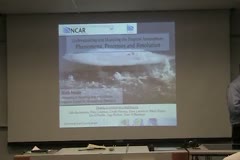
Understanding and Modeling the Tropical Atmosphere: Phenomena, Processes and Resolution
November 04, 2010
Richard Neale (NCAR)
Hosted by Dave Randall
Techniques for representing convective processes in global models are in a transitional phase. Existing assumptions for parameterizing convection are increasingly inadequate due to ever finer horizontal grids and increasing demands on their performance, but a transition to global cloud-resolving models is still severely resource limited. In this interim period climate models will need to…

Tropical squall lines and convectively coupled gravity waves: Why do most cloud systems move westward?
October 28, 2010
Stefan Tulich (NOAA)
Hosted by Dick Johnson
The existence of tropical squall line systems has been recognized for quite some time, yet their governing dynamics still remains unclear. Here it is proposed that many tropical squall lines are part of a broad family of convectively coupled gravity waves with periods in the range 6-48 hrs. Spectral filtering of high-resolution satellite rainfall data provides evidence to support this idea. In…

GOES-R Overview of Aviation and Nowcasting Applications - Current status and a look into the future
October 21, 2010
Wayne Feltz (UW-Madison)
Hosted by Steve Miller
The NOAA GOES-R Aviation Algorithm Working Group was formed in November 2006 to assess satisfying aviation related requirements as defined in the GOES-R Mission Requirements Document. A suite of aviation related products are in development and are being evaluated to assess meteorological hazards to aircraft derived from the current generation of GOES and European Spinning Enhanced Visible and…
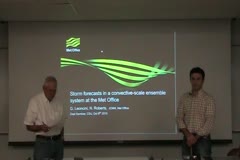
Member selection for a convective scale ensemble at the UK Met Office
October 06, 2010
Geovanni Leoncini (U.K. Met Office)
Hosted by Bill Cotton
The UK Met Office is developing an ensemble at the convective scale by embedding the new 1.5km model over the UK within selected members of the regional scale ensemble MOGREPS-R (~18km covering the North Atlantic and Western Europe). The objective is to improve our forecasting capability of high-impact local weather with a 12 to 36 hours lead time. This seminar will describe the potential…
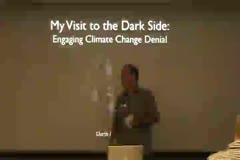
My Visit to the Dark Side: Engaging Climate Change Denial
September 30, 2010
Scott Denning (CSU)
Hosted by Dave Randall
Global climate change is no longer merely a scientific field of study but has emerged as a major issue in American popular culture and political discourse. The treatment of climate and global change is therefore now treated to political rhetoric and media spin in the same way as health care, war, the economy, and the marital difficulties of Tiger Woods. Millions of Americans believe that…
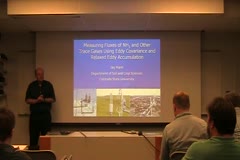
Measuring Fluxes of Ammonia and Other Trace Gases Using Eddy Covariance and Relaxed Eddy Accumulation
September 23, 2010
Jay Ham (CSU Crop and Soil Sciences)
Hosted by Jeff Collett
“when you cannot measure it, ..., your knowledge is of a meagre and unsatisfactory kind” -- William Thomson Kelvin, 1883 Measurement of energy and mass exchange in the surface boundary layer is fundamental to many research projects in atmospheric science. Eddy covariance (EC) and conditional sampling techniques (e.g., Relaxed Eddy Accumulation, REA) can obtain near…
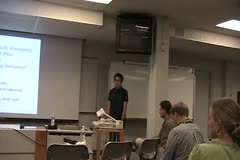
The Impact of North Pacific Atmospheric Variability on ENSO via the "Seasonal Footprinting Mechanism"
September 16, 2010
Mike Alexander (NOAA)
Hosted by Yohei Takano
Previous studies suggest that the “seasonal footprinting mechanism†(SFM), in which fluctuations in the North Pacific Oscillation (NPO), a north south dipole in the sea level pressure pattern influence the ocean. NPO-related surface heat fluxes during winter drive subtropical SST anomalies in spring, which alter the atmosphere-ocean system over the tropics in the following summer,…
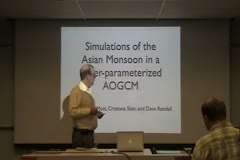
Simulation of the Asian Monsoon in a Super-parametrized AOGCM
September 09, 2010
Charlotte DeMott (CSU)
Hosted by Thomas Birner
Climate simulations using a multi-scale modeling framework (MMF), or “super- parameterization†may offer new insights into the role of convection, air-sea coupling, and equatorially-trapped waves on the simulation of the Asian monsoon system. In this study, we compare the monsoon simulation in the Community Climate System Model (CCSM, v3.0), which uses a traditional cumulus…
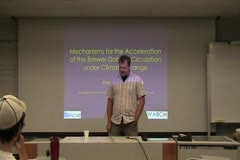
Acceleration of the Brewer-Dobson Circulation in a Changing Climate
September 02, 2010
Rolando Garcia (NCAR)
Hosted by Thomas Birner
National Center for Atmospheric Research, Boulder, CO, USA The evolution of the Brewer-Dobson (BD) circulation as a result of climate change has been analyzed using NCAR’s Whole Atmosphere Community Climate Model (WACCM). Two experiments, one with observed greenhouse gas (GHG) concentrations and SSTs from 1950-2003, and one in which GHG concentrations follow the A1B IPCC for the…

Faculty Intro Jamboree
August 26, 2010
Birner, Denning, Heald, Ito, Johnson, Maloney, Thompson, Vonder Haar
Hosted by Thomas Birner
5-10 minute intros by individual faculty members to provide an overview of their research areas and groups in the department.
